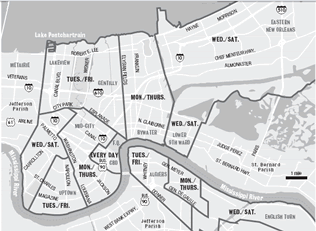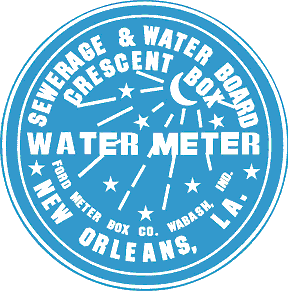PreK New Orleans Municipal Government operated on about $600 million per year. (shown above). PostK, with half the people, it looks like $700 million won't quite be enough.
The
Louisiana State Constitution specifies how the parishes in the
state are to be governed. It contains provisions for criminal justice,
education, property assessment, levee districts and provides for incorporation of
cities. Since 1870 the city of New Orleans has been coterminus with the
Parish of Orleans. The city charter provides for city services and the
taxes and fees used to pay for those services.
Since the storm, the budget has been squeezed. PreK General Fund revenue was $486 of the $600 million total. The $114 million difference being the state and federal grants shown in dark green in the diagram above. General fund revenue in 2006 was $365 million. In October 2006 the city's revenue forecast for 2007 included $405 million. However this forecast includes $70 million of one time windfalls including loans from the federal government. So revenue from traditional sources is expected to be $335 million or about 70% of preK income.
When you comapre the revenue to the expeditures concern must grow. The garbage contract for 2007 is a case in point.
|
|
Chef Menture Landfill
: In September 2006 a new controversy over the Chef Menture landfill is emerging.
:: Continue reading...
|
|
|
Fire Fighting
: New Orleans Fire Department has been doing a good job. For a brief
:: Continue reading...
|

|
Garbage Contract
: One local firm likes to remind us "This business stinks, but it's picking up."
:: Continue reading...
|
|
|
Government Spending
: Metro Government Collects and spends $500 million in our names
:: Continue reading...
|
|
|
Gretna Police Bar Evacuation
: When on September 1, 2005, three days after the storm, people from New Orleans crossed the CCC bridge on foot to get away from the flooding and unsafe conditions
:: Continue reading...
|
|
|
Inspector General - the new city watchdog
: New Orleans Charter calls for an Inspector General to oversee operation of the government, specifically to search out and eliminate fraud. Shelley Midura campaigned on a platform that included creating the IG's office in New Orleans.
:: Continue reading...
|
|
|
Mosquito Eating Fish
: New Orleans Mosquito Control has just brought in over 10,000 mosquito
:: Continue reading...
|
|
|
New Orleans City Charter
: We, the people of the City of New Orleans and Parish of Orleans,
:: Continue reading...
|

|
NO Sewerage and Water Board
: Organized in 1899, this municipal utility (part of City Government)
:: Continue reading...
|

|
Police
: The New Orleans Police Department received lots of good and bad
:: Continue reading...
|
|
|
Property Tax Assessors
: Under the state constitution (as part of a grandfathering that took
:: Continue reading...
|
|
|
Website nola.gov
: A very good website developed since Landrieu became mayor provides access to many municipal services. The portal technology looks like Microsoft SharePoint but many of the internal features appear to be custom vendor systems from outfits like ESRI (known for its GIS and mapping systems).
My first stop was the crime maps published by the police department. Buried four levels deep and behind a Disclaimer page with which you must agree, you'll find a graphical map based reporting system powered by esri GIS software. Icons on the map show the locations of crimes in the past week (default). You can scroll and zoom the map to focus on a particular part of Orleans. A pull down menu lets you change the date range, filter by crime type(s). The data seems accurate but alarming. Watching a series of residential burglaries slowly approaching your neighborhood makes you want to shout out to the police. Zooming out to a national grid it looks like this system is in use by numerous municipalities across the country. Gulfport is the closest beyond Orleans. Dallas and Fort Worth use it. It would be great if we could get the ten parishes in the metro area to participate in one system like this.
Then I took a tour of the RTA site. Did you know New Orleans has a transit pass called the Jazzy Pass. You can get a day pass for a three bucks or 31 days for $55. Then I tried the Google Maps powered transit planner to plan a bus and street car trip from a westbank address to the Camillia Grill in RiverBend. Using Google Maps with some Sanborn GeoSpatial) customization made the system easy and informative. This is the first time I've really been confident in planning a mass transit experience. I can't vouch for the accuracy of the schedules but the directions looked accurate and very usable. The Alerts section of the schedules could use some work to make it more understandable. Once again cooperation with Jefferson and the other local parishes would make the site if not the whole RTA much more usable. One curious ommission was that even though the "Armstrong Airport" was one of the two "popular locations" listed in the destination pulldown, no trips to that location could be planned. Take a taxi.
The Assessor's have had a pretty good site for property tax records and visualization for the past years. Their new system was implemented in preparation for the 2010 combination of the seven assessors offices into a single office. The site is not directly accessible from nola.gov, at least through any link I found. Use http://nolaassessor.com/ to view the Orleans assessor's website. Jefferson Parish of course uses a different system by Bailey Link to track its property rolls. And the other eight parishes as well all use their own systems.
The Municipal Courts System is undergoing change but still operates as two systems a civil district court http://www.orleanscdc.com/ and a criminal district court http://criminalcourt.org/. That URL for the criminal district court is interesting since it does not include any locality info.
The Council site provides individual bio's, background info, calendars and pretty good "blog" style meeting summaries, but not the degree of information on meeting agendas or pending legislation that I'd like to see.
The Inspector General's office is represented with an appropriate set of pages allowing citizens to read past reports and followups as well as logging a complaint.
:: Continue reading...
|
City (covered under the City Charter and under control of the Mayor)
Police (under fire for scandals, desertions and returning crime)
Fire (holds $127 million judgement agains the city for unpaid back wages)
Medical (???)
Finance - Taxation, Money, Property (but not the Property Tax Assessors)
Housing (HANO taken over by HUD for ineffectiveness)
Garbage (contacted to Waste Managment chargin as much post-K for once a week as pre-K for twice a week pickup)
Sewerage and Water Board - operating under consent decree because of
decrepit state of 300 year old sewer lines in parts of the city)
Recreation (NORD shut down post-K)
Parks
Safety and Permits (streamlined computerized processes, master
electricians allowed to conduct inspections with homeowner permission)
Public Works - Streets and Traffic (street lights still out, wrecked cars not towed after 8 months)
Mosquito Control (offering to put fish in abandoned swimming pools)
Zoning (ignored an overridden by City Council when powerful constituents affected)
Public Belt Railroad (part of the port)
Library (half of the branches opened, excellent Nutrias website and onlline catalog service)
Parish (chartered by the State by the Constitution and legislation)
Public Schools (elected board)
Levee Board (state appointed)
Courts & Judges & Clerk (elected)
District Attorney (elected)
Jails and Sheriff (elected)
Assesors (elected)
It's a little disconcerting to see those 200 yellow school buses flooded
in New Orleans East in the aftermath of Hurricane Katrina.
Understanding the fragmented nature of the area's government can help
understand why the city was able to use RTA buses to move people from
checkpoints around the city to the Superdome but was unable to use the
school buses to get people all the way out of town.
Maybe next time there will be enough buses in the evacuation plan. 200
buses carrying 30 people each would have been enough to move the
20,000 people who showed up at the dome on the day before the storm.
Each one would have had to make three trips out of town to some place
like Baton Rouge. Then the buses could have returned to pickup up
additional evacuees after the flooding began. Of course this takes some
planning because you have to have a place to take the 20,000 or so
people you evacuate, a place outside the city under someone else's
control.